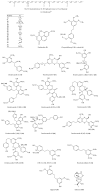Dendrobium officinale Kimura et Migo: A Review on Its Ethnopharmacology, Phytochemistry, Pharmacology, and Industrialization
- PMID: 28386292
- PMCID: PMC5366227
- DOI: 10.1155/2017/7436259
Dendrobium officinale Kimura et Migo: A Review on Its Ethnopharmacology, Phytochemistry, Pharmacology, and Industrialization
Abstract
Ethnopharmacological Relevance. Dendrobii Officinalis Caulis, the stems of Dendrobium officinale Kimura et Migo, as a tonic herb in Chinese materia medica and health food in folk, has been utilized for the treatment of yin-deficiency diseases for decades. Methods. Information for analysis of Dendrobium officinale Kimura et Migo was obtained from libraries and Internet scientific databases such as PubMed, Web of Science, Google Scholar, ScienceDirect, Wiley InterScience, Ingenta, Embase, CNKI, and PubChem. Results. Over the past decades, about 190 compounds have been isolated from Dendrobium officinale Kimura et Migo. Its wide modern pharmacological actions in hepatoprotective effect, anticancer effect, hypoglycemic effect, antifatigue effect, gastric ulcer protective effect, and so on were reported. This may mainly attribute to the major and bioactive components: polysaccharides. However, other small molecule components require further study. Conclusions. Due to the lack of systematic data of Dendrobium officinale, it is important to explore its ingredient-function relationships with modern pharmacology. Recently, studies on the chemical constituents of Dendrobium officinale concentrated in crude polysaccharides and its structure-activity relationships remain scant. Further research is required to determine the Dendrobium officinale toxicological action and pharmacological mechanisms of other pure ingredients and crude extracts. In addition, investigation is needed for better quality control and novel drug or product development.
Conflict of interest statement
The authors declare that they have no competing interests.
Figures
References
-
- Li X. X. The Phylogenetic of Chinese Dendrobium and Protection and Genetics Research on Dendrobium Officinale. Nanjing, China: Nanjing Normal University; 2009.
-
- Huang M. Q., Huang B. H., Cai T. Y., Liu Q. L., Li D., Chen A. Z. Extraction, isolation and analysis of Dendrobium officinale's polysaccharides. Chinese Traditional and Herbal Drugs. 1994;3:128–129.
Publication types
LinkOut - more resources
Full Text Sources
Other Literature Sources
Miscellaneous




